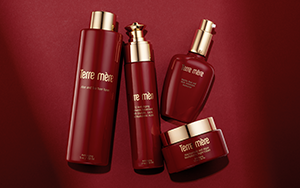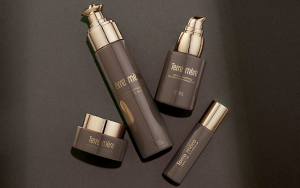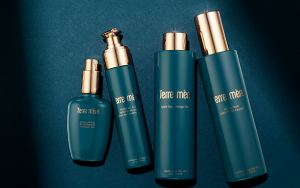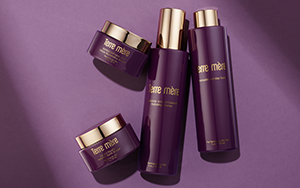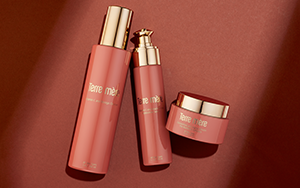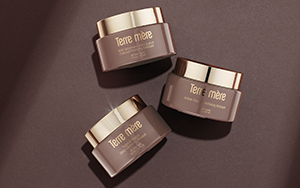
Terre Mere banned over 1,600 ingredients that are known to cause issues for your skin and or the environments according to the European union, US Food and Drugs Administration and the Canadian Health Department.
Here are the most common harmful ingredients found in the cosmetics industry and NOT in our formulas:
Phthalates
Often used under the term ‘fragrance’ in cosmetic labeling, Phthalates are a plasticizing chemical used in some perfumes and nail enamel to dissolve other chemicals. Banned in the European Union, this ingredient is associated with reproductive harm, developmental toxicity, and hormone disruption.
Parabens
Utilized as an artificial preservative in body and cosmetic care products, Parabens are a group of chemicals used to increase shelf life while reducing and preventing harmful mold and bacteria growth. This ingredient causes concern with its carcinogenic attributes and link to reproductive harm, irritation and toxicity of significant organs, allergic response, and hormone disruption.
Sulfates
Used as a cleaning agent and to keep ingredients together, Sulfates are found in a plethora of personal care and cleaning products. This ingredient is associated with hypersensitivity of the immune system's allergic response and has been linked with organ irritation and toxicity.
Insoluble Plastic Microbeads
A synthetic plastic polymer, Insoluble Plastic Microbeads are used as an exfoliant in some cosmetic cleanser formulations. Known for accumulating in the environment causing harm, this ingredient is associated with reproductive and hormone disruption.
Butoxyethanol
Utilized as a solvent, fragrance additive, and viscosity control, Butoxyethanol is a carcinogenic organic compound found in some face, hair, body, and cosmetics products. A substance that has the potential to cause cancer, this ingredient is linked to reproductive harm and has associations with organ irritation and toxicity.
Colorant
Sometimes referenced as Carbon Black on ingredient labels, Colorant is used in the cosmetics industry to produce color in some face products, eye makeups, and nail polishes. Known for its powdery consistency, Colorant has links to organ toxicity and cancer.
Ethanolamine Compounds
Appearing on ingredient labels as DEA, TEA, MEA, ETA, Ethanolamine Compounds are utilized in various personal care and beauty products as pH stabilizers. Sometimes contaminated with chemicals like Nitrosamines, this ingredient has some cancer-causing attributes with links to organ irritation and toxicity, allergic responses, nervous system damage, reproductive harm, and endocrine disruption.
Talc
Used in an array of consumer products, Talc (with Asbestiform) is sometimes found in cosmetics and body powders. Talc derived from hydrous magnesium silicate can contain small portions of asbestos fiber contamination from aluminum silicate. The asbestos fibers have links with cancer and respiratory irritation.
Triclosan
An antimicrobial agent sometimes used in soap, hand sanitizer, and antiperspirant, Triclosan, is known for its potential contribution to water and soil contamination in the ecosystem. This ingredient also has links to hormone disruption with associations to organ irritation and toxicity.
Triclocarban
Utilized as an antimicrobial in some anti-bacterial soaps, Triclocarban is associated with adverse environmental impacts on our soil and water ecosystems. No longer common in beauty and personal care products, this ingredient is a known contributor to hormone disruption with links to organ irritation and toxicity.
Mineral Oil
Commonly used as a moisturizer, Mineral Oil is a petroleum-derived ingredient used in some face, body, and cosmetic formulations. This ingredient is a potential cancer-causing carcinogenic substance linked to allergic responses with organ irritation and toxicity associations.
Coal Tar
A semi-solid or thick liquid, Coal Tar is sometimes used as an anti-dandruff agent or colorant in hair care and cosmetics formulations. The ingredient has known cancer-causing carcinogenic properties with links to allergic skin reactions and respiratory toxicity.
Nanoparticles
Engineered particles that are extremely small, Nanoparticles are used to change an ingredient's function to create UV protection, enhance texture and penetration of products, stabilize, and persevere formulations. Nanoparticles are not explicitly mentioned on ingredient labels, but some companies claim to be "non-nano." The statement of a product being "non-nano" is often deceiving due to the broad definition of Nanoparticles proposed by the Food and Drug Administration. While there is a need for Nanoparticles in SPF's that protect the skin's health, it is advised to avoid using them in inhaled products (sprays and powders) where respiratory irritation can occur. Some groups advise against the use of new nanoparticles due to a lack of environmental and safety data.
Acetaldehyde
Classified as a possible cancer-causing carcinogen, Acetaldehyde is a fragrance compound used in some cosmetics formulations. This ingredient has known links to adverse skin reactions with mild respiratory tract reactions with exposure.
Benzalkonium Chloride
A class of chemicals, Benzalkonium Chloride, is sometimes used as an antimicrobial ingredient found in disinfectant cleaners and hair conditioners. Dangerous for people with asthma or pre-existing skin conditions, this chemical has links to severe eye, skin, and lung irritation.
BHA
Utilized as a preservative and antioxidant, BHA (Butylated Hydroxyanisole) is sometimes used in hair, face, body, and cosmetics formulations. The ingredient has possible associations with organ irritation and toxicity with links to cancer and hormone disruption.
Click here for the European LIST OF SUBSTANCES PROHIBITED IN COSMETIC PRODUCTS

